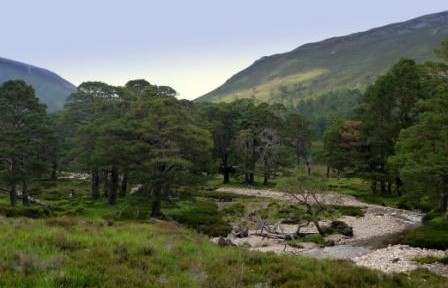
Summer in the pinewoods….queen wood ants are on the wing, ground beetles are scurrying, dor beetles are dumbling, fritillaries are fluttering, redstarts are singing, crossbills are foraging….there’s nowhere else I’d rather be!
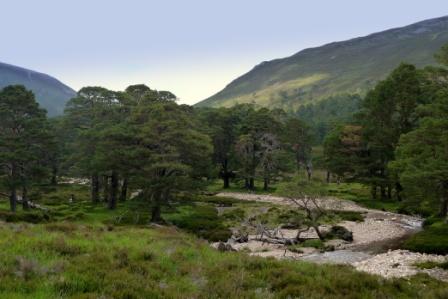
I’ve just spent 6 weeks at the gorgeous Mar Lodge Estate, Braemar which is owned by the National Trust for Scotland (NTS). They have been working hard to monitor their small, but very important population of narrow-headed ants (Formica exsecta), an endangered species in the UK and related to the mound-building wood ants. Scotland holds the vast majority of the population of this amazing little ant, which like its larger cousins the big wood ants, creates thatched mounds to live in. I’ve been helping NTS with a monitoring programme used to keep a close watch on the status of these ants at the estate.
As I mentioned in my April blog, Formica exsecta needs open habitat, but still within the vicinity of pine or birch woodland. Unlike the wood ants, it isn’t able to warm up it’s nest using metabolic heat and so it’s entirely dependent on the sun for warmth – warmth needed to be active to forage, build and repair the nest and of course for the brood to develop. Without the right levels of sunlight the nests cannot survive. Therefore, it is essential that their nests do not become overgrown by surrounding vegetation (mainly heather and trees). Conserving the habitat of this species is tricky as most estates (including Mar Lodge) are trying hard to remove deer and encourage pinewood regeneration, but this ant needs open habitat and grazing levels that keep the vegetation down. The Mar Lodge ecologist, Shaila Rao devised a monitoring programme for Formica exsecta, involving annual photographs to monitor changes in the size/shape of the nests and measuring vegetation in 20m of the nest every three years to track changes in vegetation height and composition.
The nests look different to wood ant nests; they hardly ever have pine needles in the thatch and are made of pieces of heather and grass. Narrow-headed ants are distinctive in that they have a notch on the top of their head which is lacking in the wood ants. They also can give a bit of a nip – their jaws are strong for cutting up pieces of heather for the nest and apparently to decapitate other ants!! The photo on the right shows you how big there are – here they are crawling over my ruler (if you look closely you will see the notch in the back of their heads).
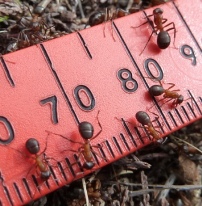
I found a new nest which was very exciting (see pic below), I’d spent many hours trawling the heather to try and find one! It wasn’t a “new” nest, simply one that hadn’t been found before. Shaila found two nests back in May, so it’s a sign there could be more nests out there. Three of the existing nests had been abandoned – these nests had all become overgrown – but fortunately had relocated within 6m. This is good news, suggesting there is enough suitable short vegetation nearby for ants to colonise. Sadly, this may not always be the case – in some parts of the estate where F. exsecta lives heather height has increased since monitoring began and pine regeneration is taking place rapidly. If something isn’t done these nests will become shaded out. In a perfect world, the ants would be able to move their nests away from these pine trees to open spaces, but because their dispersal rate is so poor (queens tend to move on foot rather than fly), this might not be feasible. Some gardening so to speak may be needed to maintain open spaces for the ants if vegetation growth overwhelms them…we’ll need to keep a close eye on them and see what happens!
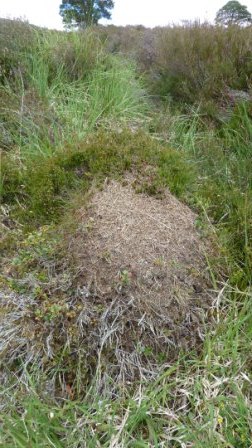
While I was busy looking for narrow-headed ant nests I saw loads of other critters; emperor moth caterpillars, a northern eggar, winged queen and male wood ants taking to their air to mate (see pic of male wood ant below), oil beetles, tons of lizards, fritillaries, wintergreens, orchids, tiger beetles, redstarts, crossbills, red squirrels, mountain hares…the list is endless! The mozzies and midges played their part too, and I did pick up a couple of ticks….but they won’t keep me away from my beloved pinewoods!!
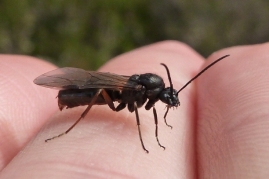
While at Mar Lodge I also assisted Forest Research (a branch of the Forestry Commission) with monitoring work for the pine lappet moth (Dendrolimus pini), a lovely fluffy moth which has not been recorded as a resident in Scotland till quite recently. These moths were found breeding near Inverness and are thought to have come over from Europe, though how they got here is currently unclear. In Poland and Germany this moth is a serious defoliator of scots pine so the Forestry Commission are eager to find out if this moth is more widespread in Scottish pinewoods. Sticky traps called Delta traps containing the pheromone produced by the female pine lappet (to attract males in breeding season) have been placed in Caledonian pinewoods around the Cairngorms (including Mar Lodge) to see if any remnant populations of this moth have been missed. I helped to check 12 traps placed at Mar Lodge and so far, all the traps have been negative (which is good news!) but survey work continues to keep a close eye on this potential pest species.)
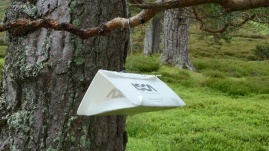
This week I’ve moved over to Abernethy Forest to spend just over 5 weeks with the RSPB (only 5 weeks, not fair!!) studying the Formica exsecta ants there and potentially some deadwood beasties….I’m such a lucky girl!!!
Hayley
Caledonian Pinewood Invertebrates
